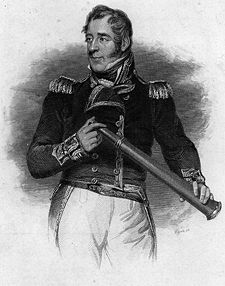 Joseph Campbell wrote in his The Hero with a Thousand Faces that all stories follow the ancient patterns of myth and legend. Whether the heroes of nautical fiction quite fit Campbell’s monomyths is open to question but there is no doubt that nautical fiction has had its own well established archetypes.
Joseph Campbell wrote in his The Hero with a Thousand Faces that all stories follow the ancient patterns of myth and legend. Whether the heroes of nautical fiction quite fit Campbell’s monomyths is open to question but there is no doubt that nautical fiction has had its own well established archetypes.
The greatest single archetype in nautical fiction is a character based on the career of Admiral Lord Cochrane. Forester’s Horatio Hornblower and O’Brian‘s Jack Aubrey are based closely on Cochrane. Kent‘s Admiral Bolitho and Pope‘s Lord Ramage bear more than a passing resemblance.
The Cochrane of history seems to be straight out of fiction. He was a penniless lord who rose through the ranks to become the greatest single ship captain the world had ever seen. Napoleon referred to him as the “loup des mer”, the “Sea Wolf”. He was invariably out numbered and out gunned but succeeded by relying upon equal parts skill and trickery. He triumphed by audacity, bluster, and bluff. Fearless both in the face of the enemy and his own commanding officers, to whom he rarely showed the respect that they thought they deserved, he was often out of favor with the Admiralty, even in victory.
Both Hornblower and Aubrey looked remarkably like Cochrane and Aubrey had a similar family background. The events in O’Brian’s first Aubrey/Maturin novel, Master and Commander, were lifted straight out of Cochrane’s Autobiography of a Seaman.
Cochrane’s unlikely victory over the Spanish frigate GAMO; of 32 guns (mostly 12 pounders) and a crew of 319, by Cochrane’s sloop, SPEEDY, of only fourteen 4 pounders and a crew of 50; was duplicated in Jack Aubrey’s fictional victory in Master and Commander over the 32 gun Spanish frigate CACAFUEGO by Aubrey’s 14 gun sloop, SOPHIE.
From this uneven battle one can image the creation of one of O’Brian’s more memorable characters, the ship’s surgeon, Doctor Maturin. After the GAMO and Cochrane’s SPEEDY began exchanging broadsides, in which most of the Spanish shot passed over the deck of the tiny sloop, Cochrane decided their only chance was to take the frigate by boarding. He left the ship’s surgeon at the helm of the SPEEDY and led the rest of the crew up and over the frigate’s rail. At the peak of the fighting, Cochrane yelled down to the ship’s surgeon, the only one still aboard the SPEEDY, to send over another fifty men. The surgeon yelled back that they were on their way, at which point the Spanish defenses collapsed and the GAMO surrendered.
O’Brian continued to follow Cochran’s career in his novels. His Reversal of the Medal follows in fiction Cochrane’s disgrace after being caught up in a stock fixing scandal. Likewise Aubrey and Maturin also follow Cochrane in his exploits in South America. Indeed they cross paths in one of O’Brian’s later books. Regrettably O’Brian treats Cochrane rather shabbily in his fictional portrayal.
Forester’s Hornblower doesn’t follow Cochrane’s career as closely as O’Brian’s Aubrey, yet may be closer in Cochrane’s temperament and personality, though Hornblower is laden with a large helping of insecurity and self doubt, which is not evident in Cochrane’s diaries or logs.
The “Cochrane” archetype that developed in nautical fiction has numerous variations but is generally that of a gifted upstart, often from a good family yet as often a family out of favor or suffering from diminished circumstances. Where Cochrane’s father as an eccentric with radical views who squandered the family fortune, Jack Aubrey’s father is a disgraced Tory general, while Lord Ramage’s father is an admiral unjustly court-marshalled. Bolitho is the second son of a prestigious naval family, marked by the disgrace of his older brother. Hornblower is the exception. As the son of doctor his background is closer to Nelson’s than Cochrane’s.
All the characters based on Cochrane share his courage and wit. They invariably are sent on “detached duty” where they will have the opportunity to face overwhelming odds and to triumph regardless. In the hands of skilled authors the books based on the Cochrane archetype make for wonderful reading. Four of the most popular writers – Forester, O’Brian, Kent and Pope, collectively wrote roughly 80 novels based on their interpretations of this character. Dozens of other authors have written hundreds of other nautical adventures, all with main characters that owe at least a nod of an admiral’s hat to the life and career of Thomas Cochrane, 10th Earl of Dundonald.
NEXT – Moving Beyond Cochrane: Pressed-men, Yanks, Bastards and Maoris

Pingback: : Old Salt Blog – a virtual port of call for all those who love the sea